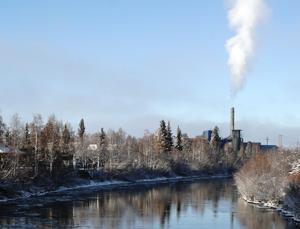UPDATE: The Environmental Protection Agency (EPA) has just approved a revised air quality plan for the Fairbanks North Star Borough, eliminating a controversial energy rating requirement that could have significantly impacted the local real estate market. This decision, announced last week, comes after mounting pressure from local officials and community advocates who expressed concerns about the burden on homeowners and realtors.
Previously, the Biden administration’s air quality plan mandated that homeowners obtain an energy rating before selling their properties, a requirement that would have imposed additional compliance costs on real estate transactions. The EPA acknowledged that this provision would have particularly affected residents, including many service members who often sell their homes when deployed. “This unnecessary and costly provision would hurt Alaskans,” the EPA stated in its press release.
Local stakeholders, including the Greater Fairbanks Board of Realtors and the Chamber of Commerce, launched a public awareness campaign that successfully prompted the EPA to reconsider this requirement. Realtors warned that the energy rating process would slow down home sales, especially given that Fairbanks currently has only two certified energy raters available.
Alaska’s congressional delegation, aligned with local interests, called for a review of the plan and received backing from the Trump administration’s EPA. The Alaska Department of Conservation (DEC) had initially set to implement the rule in 2024 with a start date of January 1, 2026, but recent developments have led to a swift reevaluation.
In a statement, EPA Administrator Lee Zeldin emphasized the importance of balancing environmental protection with the economic well-being of Alaskans. “Alaskans shouldn’t have to sacrifice their way of life to protect human health and the environment,” he said, highlighting the collaborative efforts that led to a more workable solution.
Governor Mike Dunleavy praised the revisions, stating, “This plan reflects a collaborative effort between state, local, and federal partners who share a common goal of clean air for the people of Fairbanks and surrounding communities.” Senator Lisa Murkowski echoed these sentiments, noting that while residents strive for cleaner air, they should not bear additional costs. She criticized previous Biden-era mandates as overly burdensome.
Senator Dan Sullivan labeled the updated plan as a significant advancement for Alaskans, showcasing effective state and federal cooperation. Representative Nick Begich emphasized that the EPA’s decision is a “game changer for the Interior,” aiming to reduce energy costs and enhance residents’ quality of life by rolling back restrictive mandates.
The updated State Implementation Plan (SIP) is designed to address serious air quality issues primarily caused by wintertime wood stove use, with the Fairbanks and North Pole areas classified as serious nonattainment zones due to elevated levels of fine particulate matter (PM2.5) emissions. According to the DEC, wood stove smoke accounts for up to 90% of PM2.5 emissions in the North Pole area and 60% in Fairbanks.
Despite the removal of the energy rating requirement, the SIP will still enforce several measures aimed at achieving air quality targets by the end of 2027. These include stricter regulations on home heating devices and power plant emissions, along with enforceable particulate emission limits.
The EPA has also indicated that it will lift the freeze on federal highway funding for the Fairbanks area, contingent upon the completion of any remaining conformity determinations. This move is expected to enable critical infrastructure projects without compromising air quality.
For further details on the revised air quality plan and its implications, please visit the EPA’s official website at www.epa.gov/ak/final-fairbanks-air-quality-plan. This decision not only reflects a critical shift in air quality management but also underscores the importance of local voices in shaping environmental policy.






